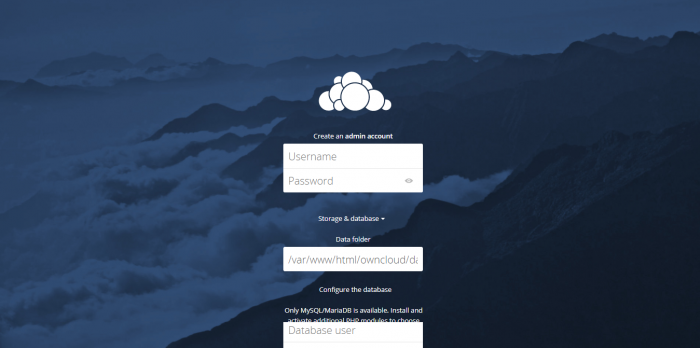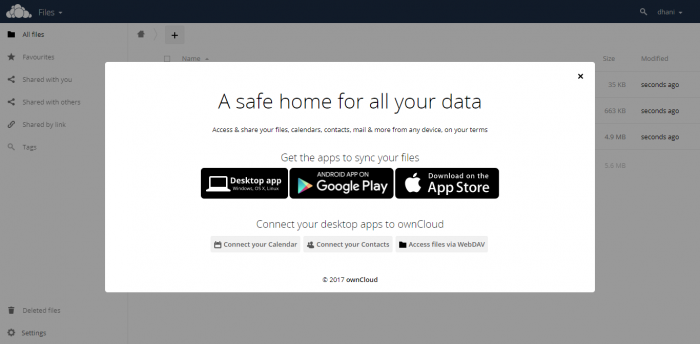How to install Owncloud 10 on Debian 9
http://manjaro.site/install-owncloud-10-debian-9/
Debian Tutorial – Today’s tutorial we will show you how to install Owncloud 10 on Debian 9 Stretch. Owncloud 10 has been released a while ago with so many features and bug fixes. Owncloud is a popular cloud and file sharing appliance that can be easily installed on Linux based server such as Debian. Install Owncloud on Debian 9 is very easy and there are many tutorial describing how to install Owncloud on Debian 9 server.
Owncloud Debian is a great combination that provide a reliable system. If you are running Ubuntu, the following tutorial to install Owncloud 10 on Debian 9 also applicable to Ubuntu 16.04 or Ubuntu 17.04 with some modifications.
Steps to install Owncloud 10 on Debian 9
- Update System
- Install LAMP Server on Debian 9
- Install Owncloud 10
- Owncloud configuration via web browser
Step 1. Update System
I assume you connect to the Debian 9 Server via SSH or Terminal. Now we need to update our Debian system first prior to the next steps.
1
|
apt update && apt upgrade
|
Step 2. Install LAMP Server on Debian 9
Now we need to install and configure LAMP Server on Debian 9. Please read our previous tutorial to install LAMP Server on Debian 9. Additionally, we need to create a new MySQL database and user
1
2
3
4
5
6
7
8
9
10
11
12
13
14
15
16
17
18
19
20
21
22
23
24
|
root@debian-vm:/tmp# mysql -u root -p
Enter password:
Welcome to the MariaDB monitor. Commands end with ; or \g.
Your MariaDB connection id is 9
Server version: 10.1.23-MariaDB-9+deb9u1 Debian 9.0
Copyright (c) 2000, 2017, Oracle, MariaDB Corporation Ab and others.
Type 'help;' or '\h' for help. Type '\c' to clear the current input statement.
MariaDB [(none)]> create database owncloud;
Query OK, 1 row affected (0.00 sec)
MariaDB [(none)]> create user owncloud@localhost identified by '12345';
Query OK, 0 rows affected (0.00 sec)
MariaDB [(none)]> grant all privileges on owncloud.* to owncloud@localhost identified by '12345';
Query OK, 0 rows affected (0.00 sec)
MariaDB [(none)]> flush privileges;
Query OK, 0 rows affected (0.00 sec)
MariaDB [(none)]> exit;
Bye
|
Step 3. Install Owncloud
Install additional packages
We need to install some additional packages required by Owncloud Server
1
2
3
4
|
apt install -y apache2 mariadb-server libapache2-mod-php7.0 \
php7.0-gd php7.0-json php7.0-mysql php7.0-curl \
php7.0-intl php7.0-mcrypt php-imagick \
php7.0-zip php7.0-xml php7.0-mbstring
|
Download Owncloud 10 package. For newer version, please check at: www.owncloud.org
1
2
|
cd /tmp
wget https://download.owncloud.org/community/owncloud-10.0.2.tar.bz2
|
Extract Owncloud and change the permission
1
2
|
tar -xvf owncloud-10.0.2.tar.bz2
chown -R www-data:www-data owncloud
|
It will produce a new directory called owncloud. We need to move this directory to /var/www/html/ directory
1
|
mv owncloud /var/www/html/
|
Configure Apache Web Server
Create a new configuration file under /etc/apache2/sites-available
1
|
nano /etc/apache2/sites-available/owncloud.conf
|
And then paste these lines
1
2
3
4
5
6
7
8
9
10
11
12
13
14
|
Alias /owncloud "/var/www/html/owncloud/"
<Directory /var/www/html/owncloud/>
Options +FollowSymlinks
AllowOverride All
<IfModule mod_dav.c>
Dav off
</IfModule>
SetEnv HOME /var/www/html/owncloud
SetEnv HTTP_HOME /var/www/html/owncloud
</Directory>
|
Create symlink
1
|
ln -s /etc/apache2/sites-available/owncloud.conf /etc/apache2/sites-enabled/owncloud.conf
|
Additional apache configuration
Execute these commands to enable some modules
1
2
3
4
|
a2enmod headers
a2enmod env
a2enmod dir
a2enmod mime
|
Step 4. Configure Owncloud via web browser
Now open a web browser and type the following address. Don’t forget to change the IP address with your IP address server
1
|
http://10.34.0.157/owncloud
|
And you will see the following Owncloud configuration windows
Enter the details required on that page and click Finish. You must use the database name and user name we created on the previous step.
Finally, Owncloud 10 on Debian 9 is now ready for use


Tidak ada komentar:
Posting Komentar